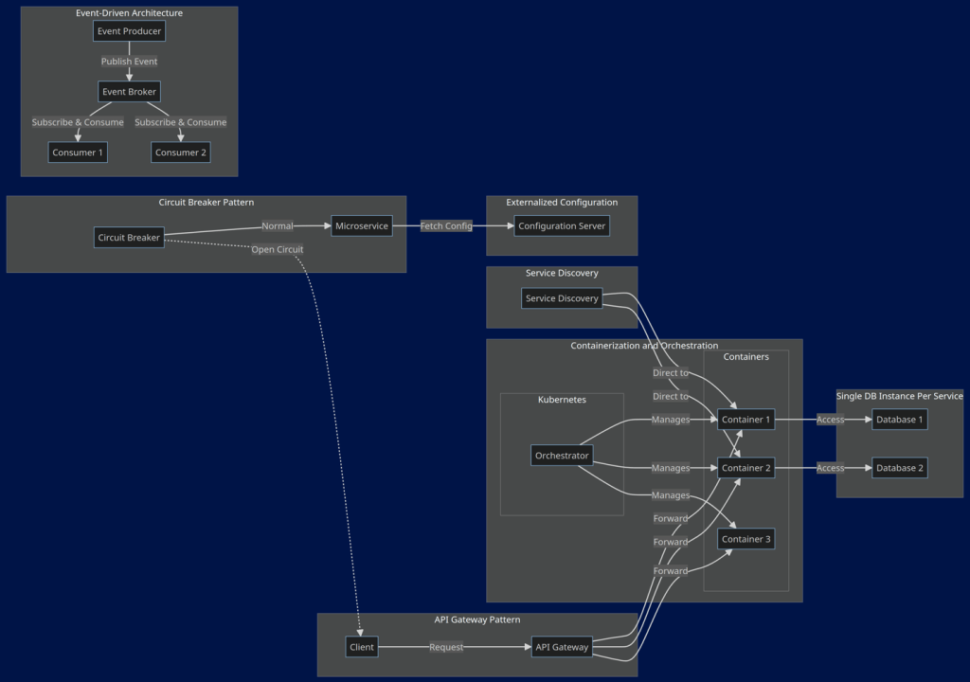In the ever-evolving realm of software engineering, the advent of microservices has marked a significant paradigm shift in application design and management. Characterized by their remarkable scalability, unparalleled flexibility, and the capacity for independent deployment of system components, microservices represent a notable advancement in architectural methodologies. However, with the increasing adoption of this approach, it becomes essential to address its sustainability. In this blog, I aim to delve into the latest design patterns that are instrumental in fostering sustainable microservices. We will explore these emerging trends and examine their impact on the future landscape of software architecture.
Microservices 101
When I think about microservices, I often liken them to a well-orchestrated symphony. In traditional software architecture, it’s like having one massive orchestra playing a complex piece all together. It’s powerful, but changing even a small part of the composition can be a big deal. Now, imagine breaking that orchestra into smaller ensembles, each playing their part, yet together creating a harmonious melody. That, in summary, is microservices for you.
Microservices architecture is all about breaking down a large software application into smaller, independent modules. Each of these modules, or ‘microservices’, does one thing and does it well. Think of them as small, self-contained services, each responsible for a specific piece of business functionality. They communicate with each other through APIs, which is like having a common language that lets them talk and coordinate.
One of the most appealing aspects of microservices is their agility. In a traditional monolithic architecture, making even minor changes can be like turning a giant ship – it takes time and a lot of effort. With microservices, however, you’re dealing with speedboats. You can update, improve, or fix one service without having to redeploy the entire application. This agility allows for quicker updates and innovation, which is a huge plus in today’s fast-paced tech world.
Another key benefit is scalability. With microservices, you can scale out parts of your application that need more resources, rather than scaling the entire application. This is like having a crowd at a concert where you can provide more seats to the popular sections without having to increase the size of the whole venue. It’s efficient and cost-effective.
However, microservices aren’t without their challenges. They can introduce complexity, especially in terms of the network of services interacting with each other. It’s like managing multiple small teams – each efficient on its own but requiring coordination to work towards a common goal. There’s also the overhead of maintaining multiple databases and transaction management across different services.
Despite these challenges, the trend towards microservices is clear, driven by the need for more scalable, flexible, and resilient software architectures. As we move forward, understanding how to build and manage these services sustainably becomes increasingly important. In the next sections, we’ll explore some of the trending design patterns that are helping to address these challenges and make microservices not just a powerful tool, but a sustainable one for the long haul.
Let’s dive deeper to understand how these design patterns contribute to the sustainability of microservices:

Diagram: Patterns Overview (Developed using Mermaid Editor)
Containerization and Orchestration
Containerization: This involves encapsulating a microservice in its own environment, complete with its necessary libraries and dependencies. Tools like Docker are commonly used for this. Containerization ensures that each microservice is isolated, reducing conflicts between services and making them easier to test and deploy.
Orchestration: Tools like Kubernetes are used for orchestrating or managing containers. Orchestration helps in automating deployment, scaling, and operations of containerized microservices. It provides capabilities like self-healing, automated rollouts and rollbacks, and service discovery, vital for maintaining a sustainable system.
API Gateway Pattern
This pattern involves setting up a single entry point for all external requests to the microservices. The API Gateway handles requests, routing them to the appropriate microservice. It can also handle other cross-cutting concerns like authentication, SSL termination, and rate limiting. This pattern simplifies client interactions with microservices and provides a layer to implement necessary security measures.
Circuit Breaker Pattern
The Circuit Breaker pattern is crucial for fault tolerance. It acts like an electrical circuit breaker, ‘tripping’ when a microservice fails or becomes unresponsive. Once ‘tripped’, it stops the application from performing operations that are likely to fail. This pattern prevents a network or service failure from cascading to other services, thereby enhancing the overall system resilience.
Service Discovery
In a dynamic environment where microservices are frequently scaled up or down, service discovery becomes essential. It allows services to find and communicate with each other over the network, dynamically locating service instances. Implementing service discovery (either client-side or server-side) ensures smooth communication and load balancing among services.
Event-Driven Architecture
This pattern involves designing microservices to produce and respond to events. An event-driven architecture helps in building loosely coupled, scalable systems. Services communicate with each other through events, reducing direct inter-service dependencies, thereby enhancing flexibility and responsiveness.
Externalized Configuration
Externalizing configurations from the service code allows a microservice to run in different environments (development, testing, production) without changes in the codebase. Configuration management tools store and serve configuration settings, facilitating easier management and consistency across services.
Database Per Service
Assigning a dedicated database to each microservice ensures that the services are loosely coupled and can be developed, deployed, and scaled independently. This approach helps in improving the performance as each service manages its data, and also enhances security by limiting database access to the owning service only.

 English | EN
English | EN 